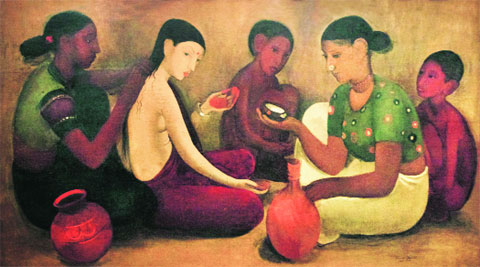- India
- International
A Life in Art
An exhibition at NGMA brings to life the idiosyncrasies of Amrita Sher-Gil
 Bride’s Toilet was a part of Amrita Sher-Gil’s famous trilogy about south India.
Bride’s Toilet was a part of Amrita Sher-Gil’s famous trilogy about south India.
By : SHIKHA KUMAR
On the second floor of National Gallery of Modern Art (NGMA), Kala Ghoda, two paintings hanging close to each other stand out. One depicts a bride’s chamber before her wedding as she gets ready, flanked by her friends. In the other are six young men, with bare torsos, their stark white dhotis in contrast with their dark brown skin. Titled Bride’s Toilet and Brahmacharis respectively, these artworks — part of Amrita Sher-Gil’s famous trilogy — have one thing in common, the large mournful eyes of their subjects.
These two paintings, perhaps, encapsulate what Sher-Gil is today best remembered for. “The trilogy showed the grace and nobility of ordinary folk. Sher-Gil was enthralled by common people, their beauty, sadness and struggles,” says Yashodhara Dalmia, the author of Amrita Sher-Gil: A Life.
Art historian Dalmia recently conducted a gallery walk of late artist Amrita Sher-Gil’s paintings as part of a show at NGMA in commemoration of the birth centenary of the late artist, born in Hungary to Sikh father and a Hungarian Jewish mother. The collection of 95 paintings belongs to NGMA in Delhi and has made its way to the city after a showing at NGMA, Bangalore.
A celebrated artist today, Sher-Gil’s ideas and expressions were thought of as isolated, especially for a woman, back in her time. “Her paintings about India depicted people in their true, gritty form and not in a sunny disposition,” says Dalmia, of Sher-Gil’s work after she moved to India in 1934. The Nawab Salar Jung of Hyderabad as well as the Maharaja of Mysore had chosen other artists’ works over Sher-Gil’s.
However, Pandit Nehru was one of the few who recognised its free-flowing and cosmopolitan nature.
Sher-Gil’s art was recognised only after her death in 1941, at 28 years. “She ushered in a way of expressing contemporary reality through modern art, something very few artists depicted,” says Dalmia.
Her Indian paintings, rooted in colour, however, were a complete change of palette from her days in Paris, where the influence of European art styles shows in her paintings, such as Young Girls, which led to her election as an Associate of the Grand Salon in Paris in 1933. Young Girls depicts her younger sister Indira and her friend Denise facing each other. “The painting showcases a stark contrast between the cultures, the dark and the fair, and is a result of Sher-Gil’s desire to show the fusion of the East and the West, an environment she grew up in,” says Dalmia.

Sher-Gil’s fascination with the physicality of humans is evident in her nudes, many of which adorn the first floor of the gallery space. The attention to detail in the contours of the female body and in the faces of women looking away, shows that Sher-Gil didn’t want their persona to be fixed and formulated but open to development, says Dalmia. The floor also features Sher-Gil’s self-portraits that show her vivacious, flamboyant self with dark lips and flowing hair. There’s also a painting of Marie Louise Chessany, who many believe Sher-Gil was involved with.
The exhibition also features photographs of Sher-Gil and a rare collection of her letters to art critics like Karl Khanadalavala. For art critic Ranjit Hoskote, who holds Sher-Gil in the league of Rabindranath Tagore and Jamini Roy, the exhibition brings her works to an audience that may not have see them before. “Sher-Gil has been a foundational figure for decades now. I wouldn’t say a showing like this aims to restore her acclaim, but in fact celebrates her as an artist,” says Hoskote.
shikha.kumar@expressindia.com
Apr 18: Latest News
- 01
- 02
- 03
- 04
- 05






































